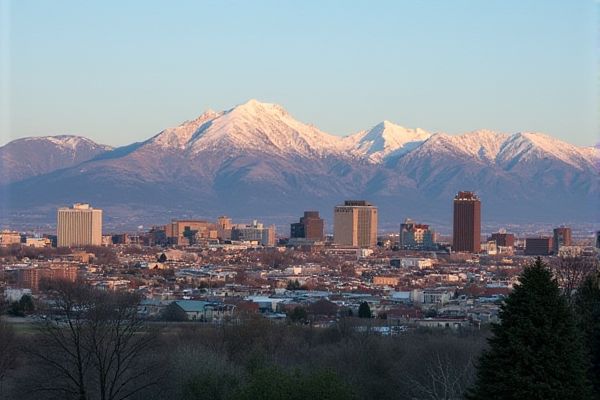
Weather and climate in Colorado: Four distinct seasons. Sunny over 300 days annually. Weather changes quickly. Low humidity year-round. Snowfall in winter months. Afternoon thunderstorms in summer. Mild, dry fall conditions. Rocky Mountain microclimates. High altitude affects temperatures. Mild springs with occasional snow.
Four distinct seasons.
Colorado experiences four distinct seasons, characterized by unpredictable weather patterns. Spring brings mixed snow and rain with occasional warm days, while summers are mild and dry with the possibility of thunderstorms. Fall features mild temperatures and vibrant Aspen colors, creating a picturesque landscape. Winters vary widely in temperature with significant snowfall, especially in higher elevations. For more detailed information on Colorado's unique climate, you can visit Colorado Christian University's Campus Life Climate page.
Sunny over 300 days annually.
The claim that Colorado receives 300 days of sunshine annually is more of a marketing myth than a factual statement. While Colorado does experience a significant amount of sunshine, the definition of a "sunny day" is vague, and actual clear days are around 115 per year in Denver, with the rest being partly cloudy or cloudy. For a deeper look into this misconception, CBS News Colorado explains how this myth came to be and its impact on local tourism and marketing strategies. Overall, it highlights the importance of understanding the nuances behind such claims rather than taking them at face value.
Weather changes quickly.
Colorado's weather is highly unpredictable due to its high elevation, complex topography, and the orientation of its mountains, which create significant climate changes even over short distances. This results in rapid temperature fluctuations and varied precipitation patterns. For a deeper understanding of the factors contributing to these weather changes, visit the article which provides an in-depth explanation.
Low humidity year-round.
Colorado experiences low humidity year-round due to its high elevation, distance from major bodies of water, and the fact that cold air holds less moisture than warm air, exacerbating the dryness during winter months. The state's continental interior Geography and Topography also contribute to its generally cool, dry climate with low relative humidity. For more details on why it feels so dry during the winter in Colorado, visit the KDVR Weather page to explore a comprehensive explanation.
Snowfall in winter months.
In Colorado, snowfall varies significantly by region; mountainous areas like Breckenridge, Crested Butte, and Vail receive heavy snowfall, with averages ranging from 170 to over 190 inches per year, while lower-elevation areas like Denver and Grand Junction receive much less, averaging around 49 and 17.7 inches, respectively. The winter months, particularly December, January, and February, are influenced by climate patterns such as La Nina, which can lead to milder and drier conditions at lower elevations but still significant snowfall in higher elevations. For more detailed information, you can visit the Annual Snowfall in Colorado website.
Afternoon thunderstorms in summer.
Afternoon thunderstorms in Colorado's summer months are common due to the North American Monsoon, which brings subtropical moisture, and the combination of orographic lift and solar heating of mountain slopes. These storms often develop over higher peaks by midday and are most frequent during the afternoon hours, particularly from July to September. For those planning to hike Colorado's highest points, it is crucial to be informed. The Expert Tips for Avoiding Thunderstorms on Colorado Fourteeners provide invaluable advice for adventurers aiming to stay safe in these conditions while enjoying their mountain pursuits. Proper understanding and preparation can greatly reduce the risks associated with these impressive yet potentially dangerous natural events.
Mild, dry fall conditions.
Colorado is anticipated to encounter a mild and dry fall in 2024, with above-normal temperatures and below-normal precipitation forecasted for September, October, and November, especially in the southwestern region of the state. According to the NWS Map, these predictions highlight a trend of warmer conditions for the upcoming season.
Rocky Mountain microclimates.
The Rocky Mountain region in Colorado exhibits highly variable microclimates due to its rugged topography, with temperature and precipitation varying significantly over short distances. Elevation plays a crucial role, as temperatures decrease and precipitation increases with altitude, and local air movements influenced by mountain slopes and prevailing winds create distinct climate patterns. For a more comprehensive understanding of Colorado's intricate climate features, visit the Britannica website which offers detailed insights into these climatic variations.
High altitude affects temperatures.
In Colorado, temperatures decrease significantly with an increase in altitude, with summer afternoon temperatures dropping about 4-5 degrees F per thousand feet, resulting in cooler temperatures in the higher mountains compared to the lower valleys and Plains.
Mild springs with occasional snow.
In Colorado, springs can be mild but are also subject to occasional snow, as the timing of snowmelt and peak runoff has shifted earlier in the spring by several weeks over the past 30 years. Lower elevations may now experience more moisture falling as rain rather than snow due to climate change. For more detailed exploration of these shifts and their implications, you can visit the Colorado's Climate section on the Water Education Colorado website.
